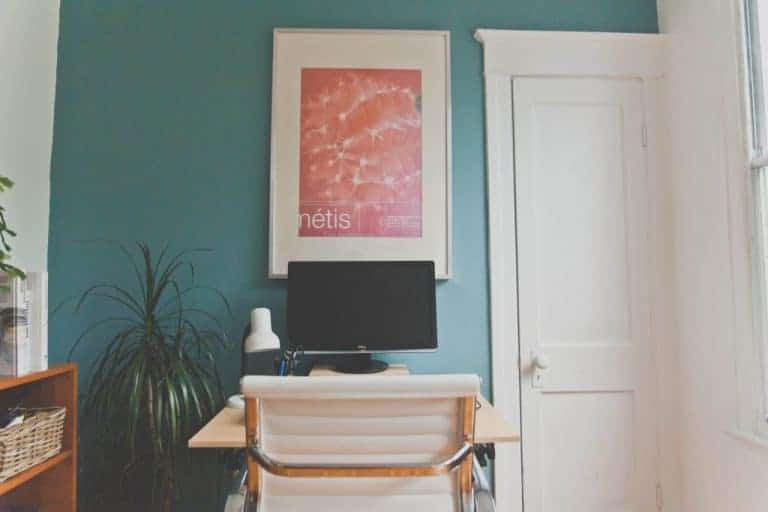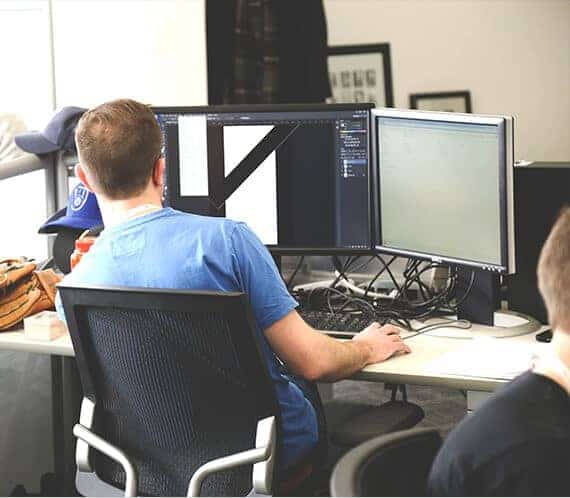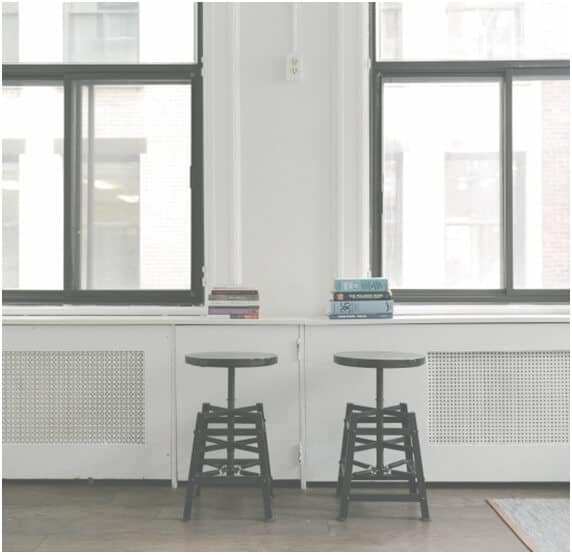Are you about to sign a Commercial Lease? Do you know about other options for your business premises? Keep reading our free guide to Commercial leases & Property below.
Where can you run your business from?
- Home Office
- Coworking Space
- Sub-Letting
- Commercial Lease
- Buying Commercial Premises
Home Office
Ah, the coveted home office! There are no words to describe the first forays into the work-from-home lifestyle. Sleeping in while your partner trudges off on their hour-long commute in the rain, listening to mid-morning TV while you browse through emails, taking your first conference call in a crisp blouse knowing all the while you’re rocking PJ bottoms and ugg boots beneath the desk – these are the joys of the home-based entrepreneur.
It all sounds wonderful, but I hate to tell you – there will come in a time for 99% of businesses that they will outgrow the home and need to move out. Perhaps you run out of space, you need meeting rooms, you’re going insane from a lack of human interaction. Whatever the cause, the home office can lose its shiny glow after a little while.


If you’re going to make it work, here are six keys things to consider:
- A dedicated space to work
- Get dressed! (no to pajamas, unfortunately)
- Keep work and personal life separate
- Avoid distractions
- Office equipment required (eg printer)
- Expenses – chat to your accountant about what expenses you can claim
If you can make it work, the home office is an easy and affordable way of running your own business. With little to no extra cost involved and no commute, it can afford business owners fabulous flexibility and is especially suitable to early-stage start-ups. On the other hand, it can be isolating and not very productive. If you find yourself falling into the latter category, it might be time to search for another option.
Coworking Space
The tech wave has also brought another wonderful innovation to our shores – the coworking space. Need commercial office space, internet and meeting rooms, but can’t afford (or afraid to commit to) a lease all on your own? No worries – the coworking space makes finding a place easy and affordable.
There are certain things you need to be aware of when signing up to either a licence (i.e. coworking) or a lease of property. We explain the key differences between them and the things you need to be aware of below.
In a coworking arrangement, the set up usually looks a little like this:
OWNER/LANDLORD > TENANT > LICENCEES
The owner of the building leases the property to their tenant, the entity that runs the coworking space. That entity then licences its members to occupy certain parts of the premises in exchange for subsidised rental fees (often called membership fees, licence fees or occupation fees). The coworking entity uses the licence or occupation fees to pay their rent to the landlord.
Important things to note:
- Who everyone is and what their responsibilities are
- The term of your agreement
- Fees
- Services provided
- Insurance coverage
- Internet security
- Compliance and Codes of Conduct


Sub-Letting
If you’re considering sub-letting part of your office, or taking up a sub-lease, make sure you think about the following:
The most important thing to know in a sub-letting situation is whether sub-letting is permitted under the head lease (i.e. the original lease between the owner/landlord and the tenant) and, if so, whether there are conditions attached.
It’s common for leases to prohibit sub-letting altogether, so it’s very important to check this before you enter into a sub-lease. If sub-leasing is prohibited altogether, you’ll need a formal variation of the lease before you can safely sub-let.
Another common term is for landlords to prohibit sub-leasing unless the landlord consents in writing. It’s important to actually get that consent in writing, but (happy days!) it’s often cheaper than a formal variation of lease.
Landlords may even specify that if you want to sub-lease your premises, the proposed sub-lessee must go through an approvals process.
Remember that when you enter into a sub-lease, it’s an agreement between the sub-lessor and sub-lessee. Unless you’ve got it in writing, the head lessor isn’t bound by the terms of the sub-lease. For example, if you were to sub-lease premises to person X, and person X failed to pay rent for 3 months, you’re still obliged to pay rent to your landlord monthly and need to keep making payments regardless.
If you enter into an illegal sub-lease, it’s a bad idea whether you’re the sub-lessor or the sub-lessee. For sub-lessors, the sub-lease will be a breach of your lease with your landlord, meaning that they can terminate the lease and kick you out. For sub-lessees, you’ve got no rights and if the landlord finds out, they can terminate the head lease and kick out the lessee (meaning that you’re out too).
Sub-letting can be a useful stop-gap for businesses in that awkward growth stage. You’re expanding your team and need more space and a sense of identity, but you’re not quote at the level where you’re ready to be on your own. While handy, sub-letting isn’t usually a long-term solution for businesses, as it can be risky and volatile.
Commercial Lease
When it comes to leasing property, you’re generally taking on a much bigger and more serious commitment than licensing coworking space, and you should take the appropriate amount of time to think it through. Go through a budget and cashflow forecasting exercise with your accountant and be confident you’ll be able to pay your rent on time each month.
The keys things you’ll want to be looking for in your lease:
How long will you be able to use the premises for? Is there an option period, where you can extend the lease?
At the end of the lease, are you required to “make good” (i.e. return the premises to its original condition)? Weigh up the fit-out costs against the lease term and make good costs to help determine if a premises is a good fit (and a good investment!)
What is the amount of rent you’re required to pay? How often? Who to and how? Think about the practicality of the arrangements and whether your cash flow will allow you to make payments as required. Consider what will happen if you have a sudden downturn in cashflow and how this would impact on your ability to pay rent. Do you have a safety net, in the form of savings or business interruption insurance?
Landlords often require tenants to pay all outgoings for the premises, meaning water, electricity and other costs, such as maintenance on air conditioning units or contributions to cleaning of common areas.
Be clear about the outgoings you’re required to pay, how often they’re due and how they will be calculated.
How often can the landlord increase your rent? Is there a regular review period or is there a trigger event, such as the exercise of an option to extend? Is there a formula set out for the increase? How will this work in practice? What will happen if you can’t agree (for example, what if you can’t agree what the new “fair market rent” is)?
What insurances will you need to have in place? Landlords often require public liability insurance coverage, with their interest noted on the policy. They may also require different types of insurance, such as plate glass insurance for office spaces, and will usually require you to produce a certificate of currency before handing over the keys.
Will the landlord be contributing to any costs? What are they? When are they required to pay? How clear is this or, on the other hand, how open to interpretation? As a general rule, you want everything in the lease to be as clear as possible, to avoid misunderstandings and disagreements down the track.
Is the landlord offering a rent-free period? How long for? How is that period defined? Are you required to pay outgoings during that period?
What else is included, apart from the lettable area itself? Does the premises come with car spaces? Are they marked? What about common areas you can use?
Leasing premises is a big commitment for any business, whether you decide to sign up from day one or day 1001. In saying that, leases offer long-term stability and sense of identity, so if you have a stable idea of your next 5 year growth and it involves a large team or stock area, then leasing your own premises is likely to be a financially sound decision. As long as you’ve got the cash flow and the consistency to keep up with the rent, you’re good here.



Buying Commercial Premises
Business owners sometimes get to the stage where it makes sense for them to buy their commercial premises. This is particularly so if you have a factory or plant.
If this is something you’re considering, keep these things in mind:
Commercial property costs a lot more than residential property. Survey the market and know what you’re likely going to be up for. Look at different types of commercial property, different locations and different sizes to find something in your budget. Figure out how you’re going to fund the purchase. Talking to a financial planner will be invaluable in helping you make these key decisions.
If you’re going to be renting some or all of the premises, consider the return. Keep in mind that while commercial property offers a greater return than residential property, it comes at a higher risk. If you’re relying on rental returns to fund the purchase, what will you do if part of the premises remains unoccupied longer than expected?
Make sure you talk to a tax advisor about the tax implications of buying, leasing and selling your commercial property.
Upkeep on commercial properties is a huge ongoing cost. Consider how you will maintain things like air-conditioning systems and facilities. Also consider how frequently you’ll need to refresh the look of the building to maintain rental interest from the market.
Factor outgoings into your budget. If you’re leasing all or part of the building, you’ll be able to recoup outgoings from tenants, but if you’re buying to occupy, you’ll be looking at that expense on top.
Buying commercial property is a serious investment, not to be undertaken lightly. Getting professional advice from a financial planner, accountant, tax advisor and lawyer is essential to ensure you’re making a smart commercial decision.
YOUR PERFECT PREMISES
The type of premises you go for will depend in large part on what your business does, your growth trajectory and your appetite for risk. If you’re a product-based business or one that requires a lot of physical space, you might be forced to go straight in at a sub-let or lease level (or even purchase!), unless you can overcome space issues with a managed warehouse solution, where an outsourced provider picks and packs your orders for you. If you’re a lean service-based business, you might start off working from home and work your way up to a lease over time. Each option comes with its pros and cons – careful decision making should help you make the right decision for your business.


